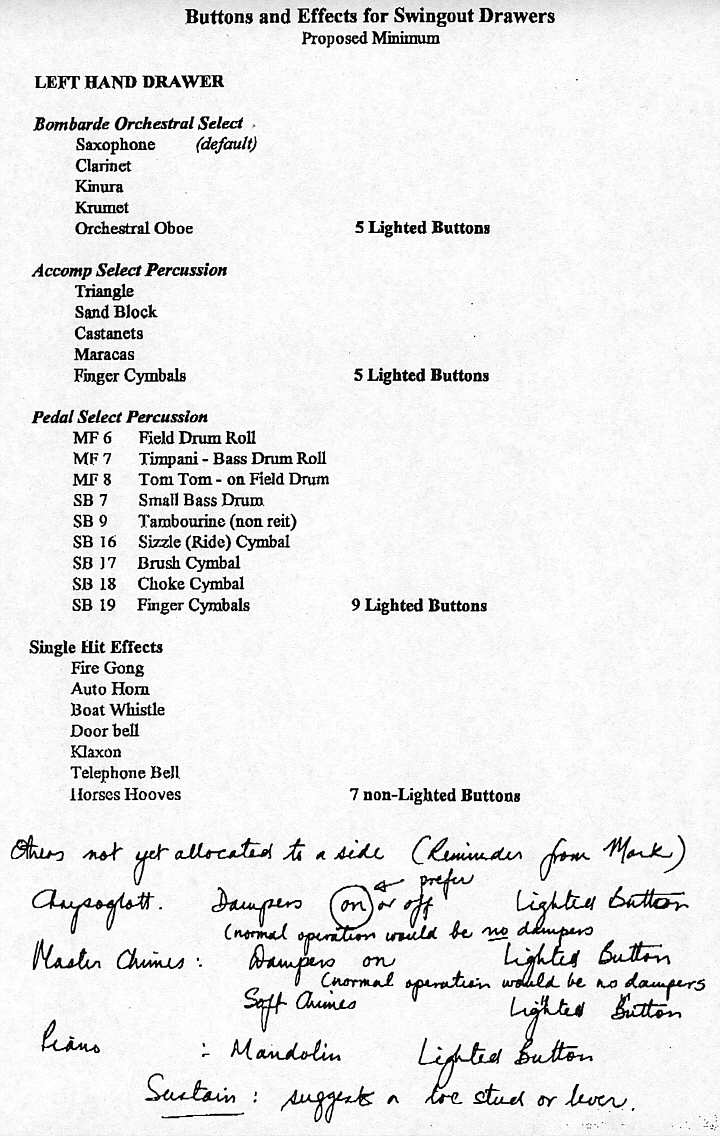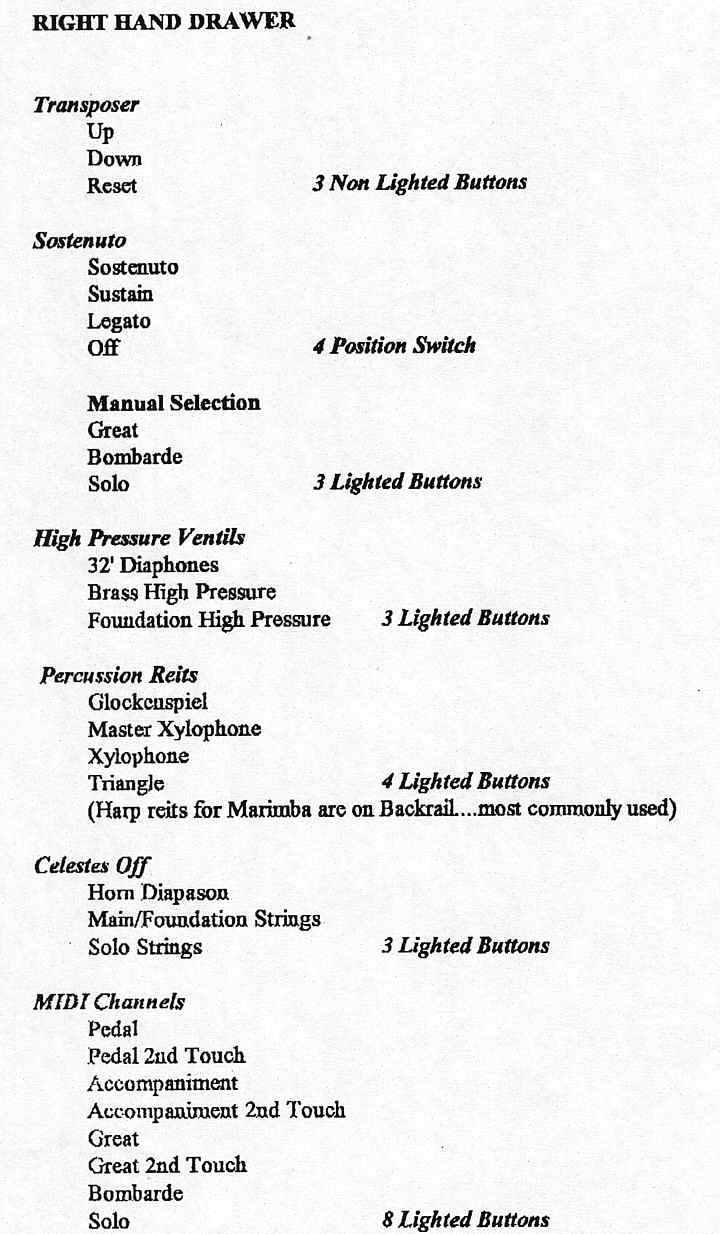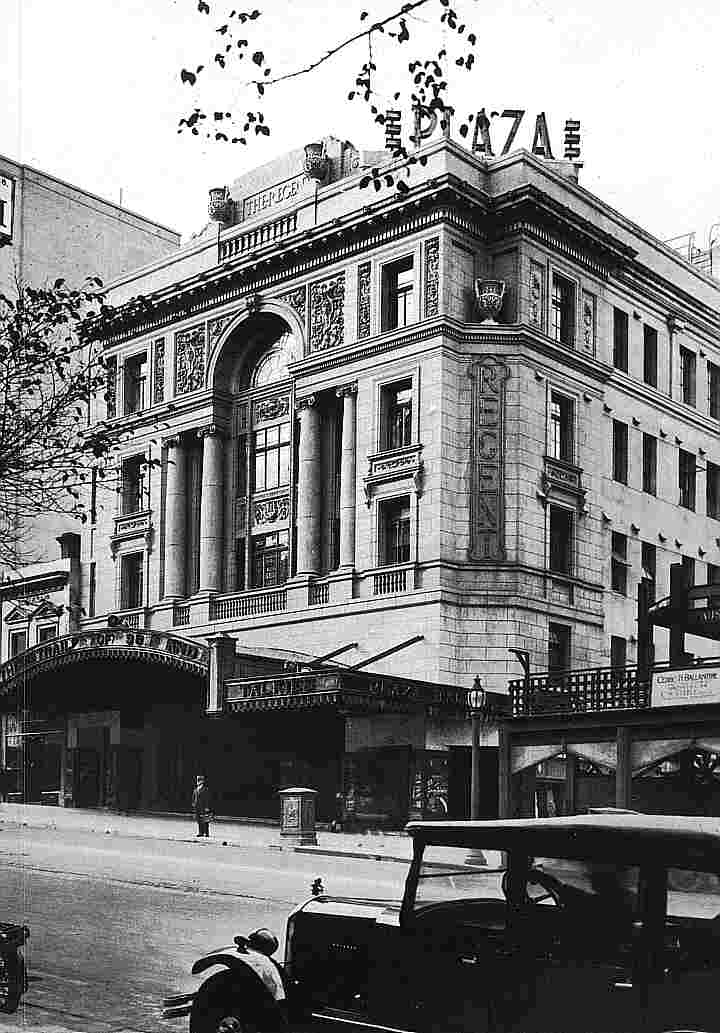
Back to Main Encylopaedia Contents
Regent Theatre, Melbourne
Please note - this is a very large web-page, with over 50 graphics. Thus it may take some while to down-load. I recommend that you view it full-screen (press F11 if using Internet Explorer).

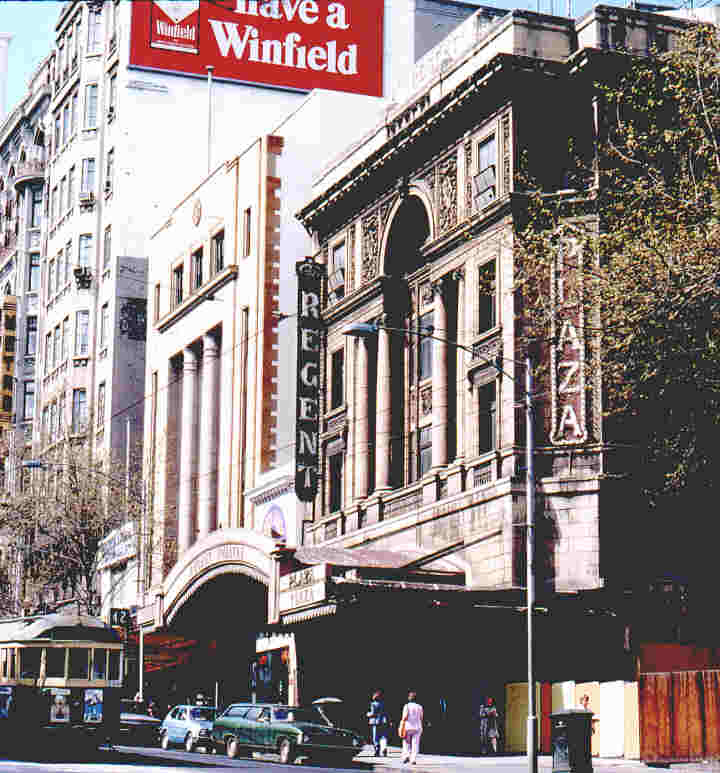
Photo: Ian McIver 1975 (the day it was announced the theatre was saved)
 Hoyt's vast Regent Theatre, with 3250 seats,[The Argus, 16 March, 1929]
was the circuit's largest theatre, and was only exceeded nationally
by the State, Melbourne. It was particularly worthy of note in that
beneath it was a second theatre, the 1235-seat Plaza, which was
also equipped with a Wurlitzer organ.
Hoyt's vast Regent Theatre, with 3250 seats,[The Argus, 16 March, 1929]
was the circuit's largest theatre, and was only exceeded nationally
by the State, Melbourne. It was particularly worthy of note in that
beneath it was a second theatre, the 1235-seat Plaza, which was
also equipped with a Wurlitzer organ.
Although Hoyt's had initiated their entry into the cinema business in Melbourne, they lacked a grand "flagship" theatre in the city at this stage. They owned or were associated with six relatively small city theatres, the De Luxe, Empire, Gaiety, Paramount, Star and Strand theatres, all in Bourke Street. [Everyone's, 7 November, 1928, p. 35]They were in danger of being over-shadowed by the Capitol (on which Hoyt's did not take a lease until 1940) and State theatres, and the construction of the Regent was timely.
The Regent opened on 15 March, 1929, and maintained the tradition of dignity and elegance which typified Hoyt's chain of Regent Theatres throughout Australia. It was an excellent example of the "hard top" style of cinema, and provided an interesting contrast to the flamboyant "atmospheric" interior of the State, which had opened only three weeks earlier:
"Viewed from Collins Street, near the Auditorium, the front of the Regent, floodlighted, is an inspiring sight. Only by night can the real beauty of its artistic outlines be realised. Marble steps lead to the vestibule, and upwards wind marble staircases which are flanked with beautiful rich hangings of crimson velvet. The vestibule has been built on Gothic lines.
Like in the Sydney Regent, Craftex has been utilised as the main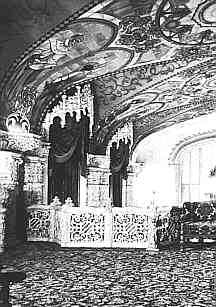 decorative effect. The roof of the balcony has been
finished with medićval effects, and it is possible to
view the entrance from the balcony. From either end
of the foyer there are entrances to the dress circle.
Valuable paintings, which glow under lights, are
hung on the walls, and the period furniture adds a
note of grandeur. Surmounted by a bronze
sculpture, one fountain was the cynosure of all eyes,
and others at either entrance attracted attention.
Murals at each end of the foyer are conspicuous on
account of their outstanding design.
decorative effect. The roof of the balcony has been
finished with medićval effects, and it is possible to
view the entrance from the balcony. From either end
of the foyer there are entrances to the dress circle.
Valuable paintings, which glow under lights, are
hung on the walls, and the period furniture adds a
note of grandeur. Surmounted by a bronze
sculpture, one fountain was the cynosure of all eyes,
and others at either entrance attracted attention.
Murals at each end of the foyer are conspicuous on
account of their outstanding design.
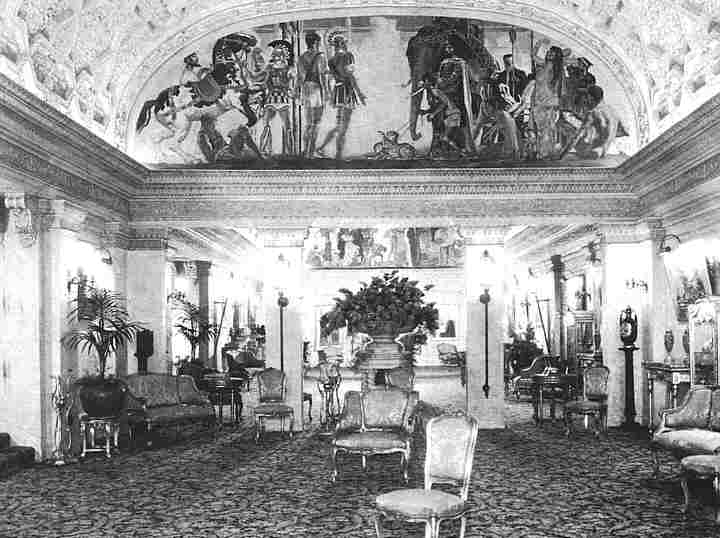
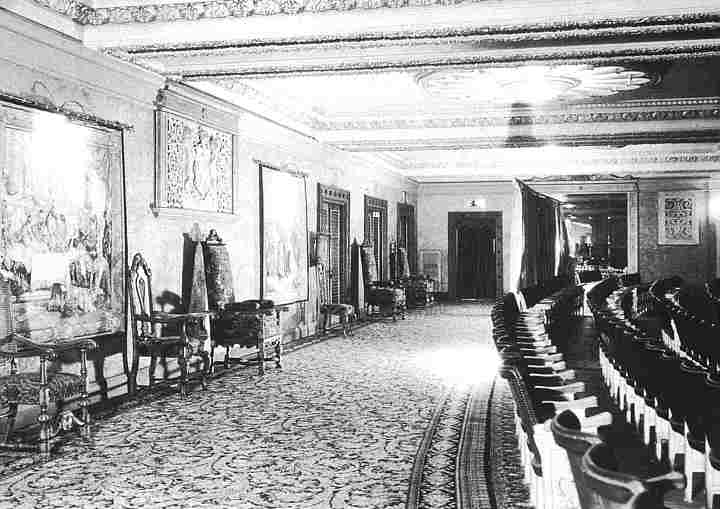
Above photos: The Regent Theatre, Melbourne's Palace of Dreams (1996 Re-opening Brochure)
On entering the dress circle from the foyer, the Roman decorative style of the auditorium is apparent. built into the walls on each side are balconies, and boxes are on either side of the stage. Right in the centre of the ceiling is an immense scintillating chandelier, which is said to weigh 2˝ tons. To raise the chandelier and lower it a special 25-horse power motor has had to be installed. Other chandeliers, smaller, have been modelled on those in the Hall of Mirrors in the Versailles Palace. Changing light colours in the dome enhance the effects." [Everyone's, 20 March, 1929]
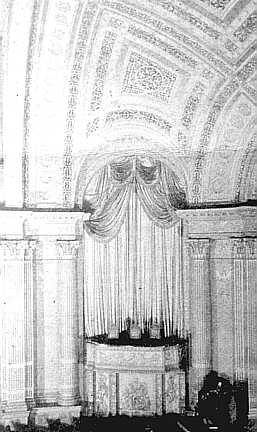
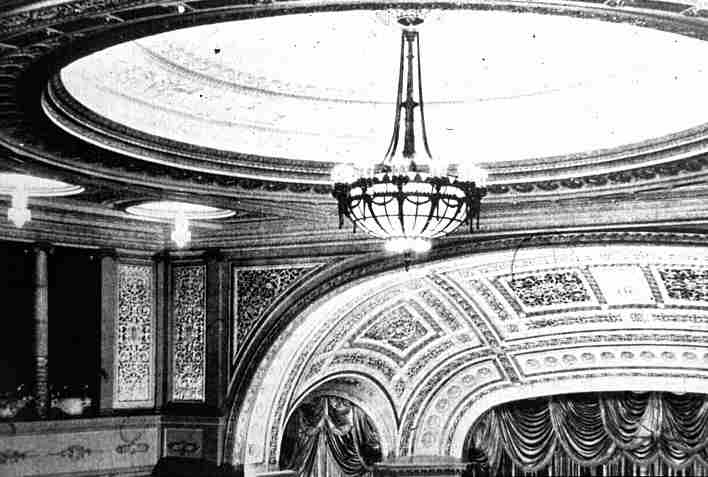
Above photos: Vox, TOSA (Vic)
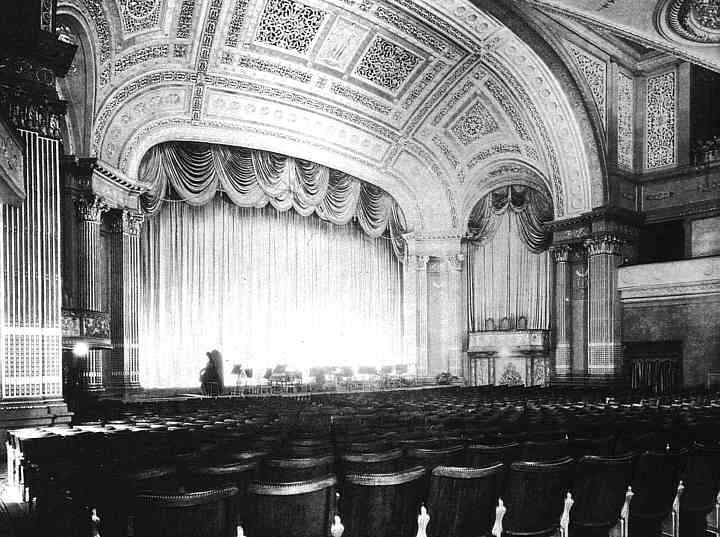
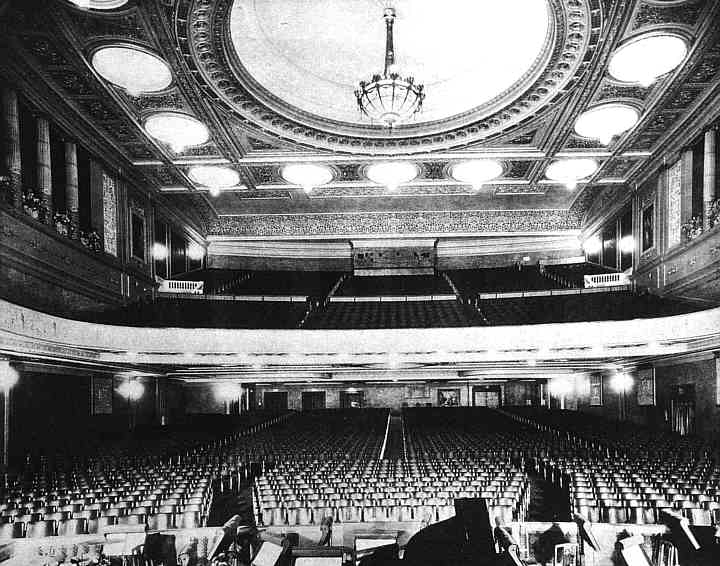
Above photos: The Regent Theatre, Melbourne's Palace of Dreams (1996 Re-opening Brochure)
"Not the least impressive feature of the huge theatre is the Wurlitzer organ, a piece of machinery of extraordinary intricacy, and embodying 600 miles of wire and 2,500,000 electrical contacts. The organ contains not only all the fea-tures of a church organ, but is a complete orchestra in itself, and is also able to imitate the ringing of fire bells, the sounding of sirens, the rattle of kettle-drums, and the clatter of horses' hoofs, and even 'arrival of a train at Spencer Street'." [The Argus, 16 March, 1929]
The Wurlitzer organ, Opus 2009, shipped from the factory on 22 December, 1928, was a twin to that at the State Theatre (specification of State organ), other than having only one console. It was Australia's second Style 270 organ, with twenty-one ranks of pipes. Its "French" style console, which was in varnished wood, was on a lift at the left-hand side of the orchestra pit, the pipe chambers being on either side of the proscenium. Photographs of the original auditorium do not show a grand piano attachment, so it cannot be stated with authority that one was fitted. The theatre's opening programme featured a full-page advertisement by Wurlitzer, announcing that "Hoyt's Theatres Ltd. Present Their Ninth Wurlitzer". [Opening Programme, Regent Theatre, Melbourne, 15 March, 1929]
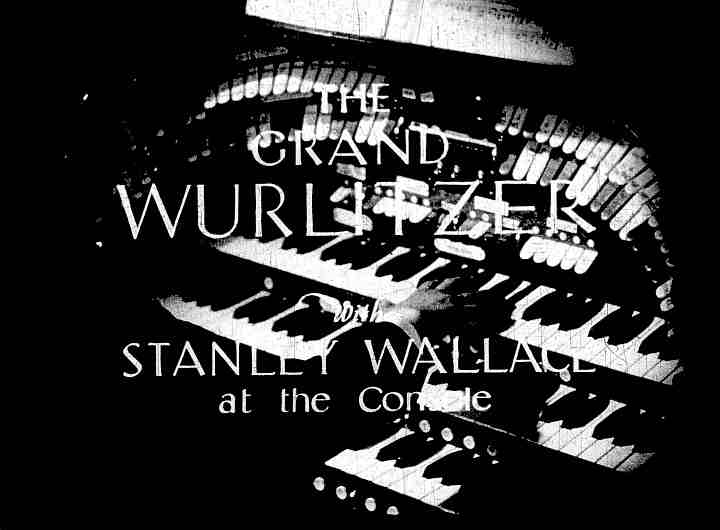
A frame from the actual nitrate film screened at the Regent to introduce Stanley Wallace on opening night
Courtesy Julian Arnold
American Stanley Wallace was the first to feature it, his contribution to the opening show being "'A Morning Wedding', a novel performance on the organ, in which various sounds, musical and otherwise, associ-ated with a wedding ceremony, are simulated." [Opening Programme, Regent Theatre, Melbourne, 15 March, 1929]
The feature film at the opening was "Two Lovers", with Ronald Coleman, Vilma Banky and Noah Beery. There was also an orchestra of 35 and a ballet of 20 performers. The orchestra was reduced after talking films arrived at the Regent about a month later. [Thiele, John, "Remembering the Regent', SA TOSA News, TOSA (SA), Adelaide, November, 1983, p. 4]
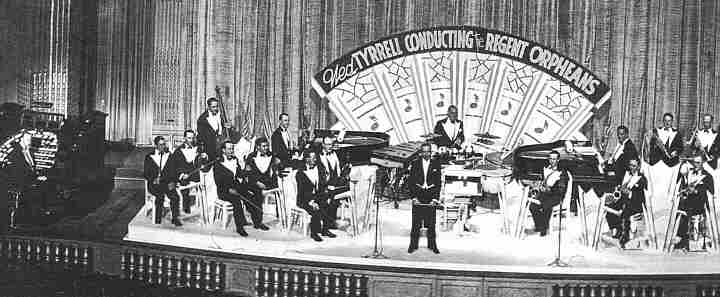
Photo: The Regent Theatre, Melbourne's Palace of Dreams (1996 Re-opening Brochure)
Stanley Wallace left the Regent during 1929, transferring first to the Regent, Sydney, then moving to Brisbane to open the Regent there in November, 1929. His assistant organist was Eileen McCarthy, who remained for some years as solo organist after Wallace left. Eddie Fitch was resident for a time from May, 1930, before returning to America. [Motion Picture Almanack, USA, September, 1930]
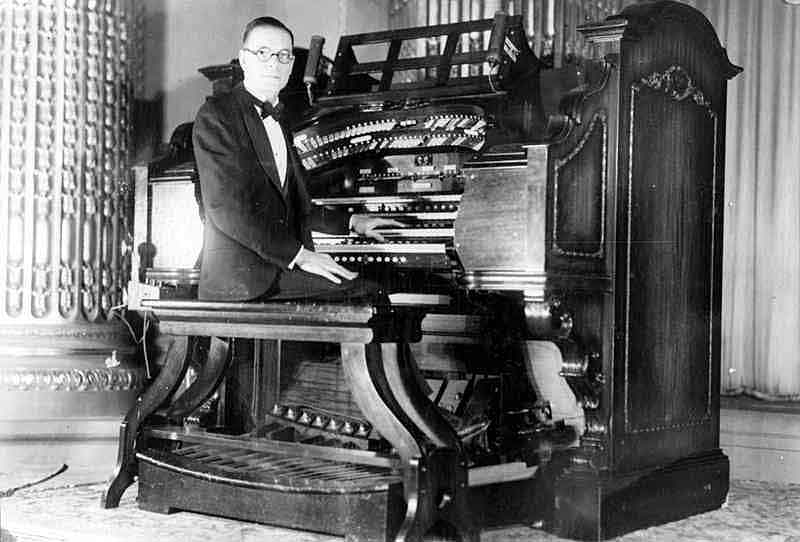
Eddie Fitch at the Regent (1930)
Again, Eileen McCarthy took over as solo organist. Lionel Corrick (perhaps the organist most associated with it) was resident for several years until 1942, except for a year's engagement in New Zealand in 1938-39, when Charles Tuckwell took his place. Mervyn Welch, was the final organist, from 1942-1945. Relief organists included Stan Seddon, Will Westbrook and Victor Riley. [March Out, Final concert programme at Regent Theatre, Melbourne, 12 January, 1969, p. 4]
Mervyn Welch's engagement was cut short on 28 April, 1945, by a fire which destroyed both the Regent's auditorium and its organ:
"The whole auditorium was completely gutted; much of the unprotected steelwork had either collapsed or was twisted and distorted; however, two main cross girders supporting the dress circle, and which were encased in terra cotta appeared to show no sign of damage. The stage safety curtain was down and protected the stage contents, but finally its sheet iron facing stripped the nails from the jarrah timber framing and fell off, thus reducing the weight sufficiently for the counterweights to raise it above the top of the proscenium opening.
Although the building was supposedly fire resistant, the great amount of decorative plaster work on the walls and ceiling was fixed to softwood framing, and it was this which was blamed for the intensity of the fire." [Thorne, Ross, Cinemas of Australia via USA, Architecture Department, Sydney University, 1981, p.304.]
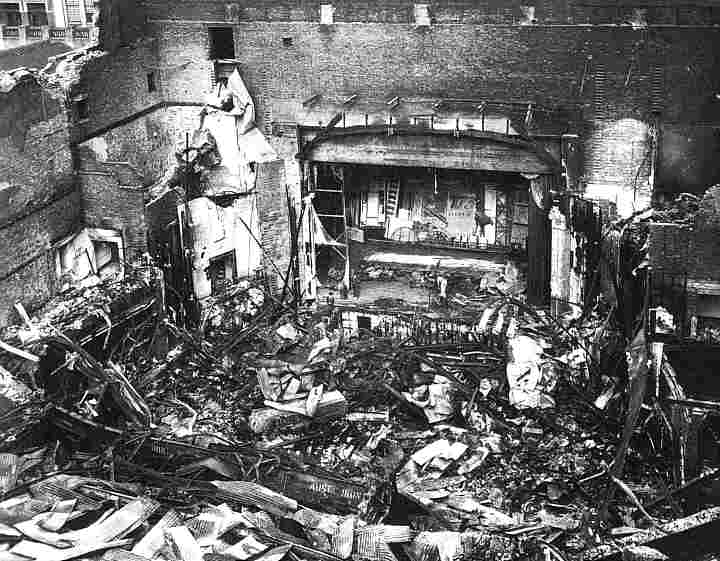
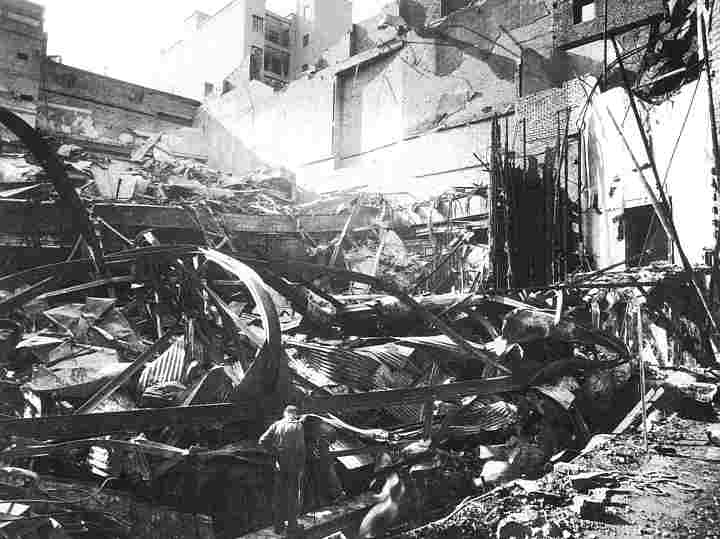
Above photos: The Regent Theatre, Melbourne's Palace of Dreams (1996 Re-opening Brochure)
Temporary roofing was erected over the remains, to protect the Plaza Theatre below, which was relatively undamaged and reopened after seven months.
Reminiscing on the 4/21 some forty years after its fiery end, organist Ian Davies recalls:
"I had the privilege of being allowed to practise on the beautiful organ, and, sitting on its stool, one was transported away into another world. At that time the organist of St. Paul's Cathedral (one Dr A E Floyd), who was very 'anti' theatre organ, was asked to come around and hear this fine Wurlitzer, and upon so doing he was amazed at the rich sound, and in particular the perfect cathedral tone of the 8ft Diapason when the instrument was played as a Grand Organ. Believe you me, coming from the good Doctor, that was a compliment indeed.
The organ was never recorded, but in those early days was regularly heard over the ABC with Lionel Corrick at the console and George Belmain, a fine baritone singer, a most popular session every Sunday night from 7:00 - 7:30 p.m." [Davies, Ian, "The Death of a Mighty Wurlitzer", TOSA News, TOSA (NSW), Sydney, October, 1985, p. 4]
Contrary to what Ian Davies says above, it has recently been suggested that two 78rpm sides recorded by Eddie Fitch accompanying singer Jack O'Hagan, described on the records as recorded in the Plaza, were actually made using the Regent organ. Some extracts from Lionel Corrick's broadcasts have also survived. Test MP3 recording
The fire, however, was not the end of the Regent, for from the ashes of the old theatre arose a new Regent, virtually as magnificent as its predecessor. The most noticeable difference was that the new proscenium was straight-topped, rather than then curved form of the original. The chandeliers were no longer based on those at Versailles. [Thorne, Ross, Cinemas of Australia via USA, Sydney, 1981, p.304.] The reconstructed Regent opened on 16 December, 1947.
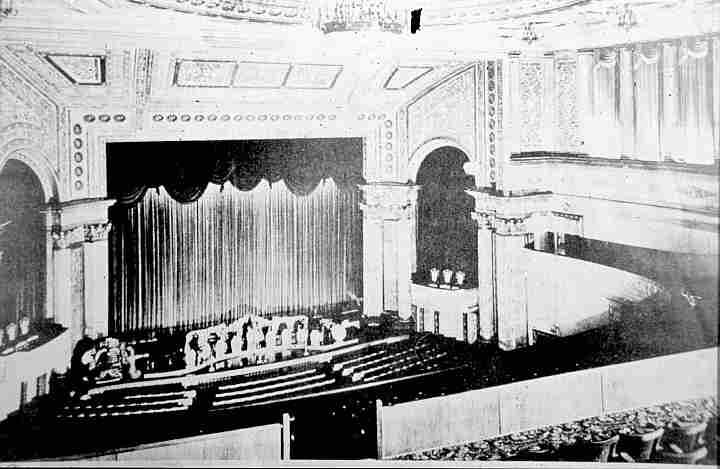
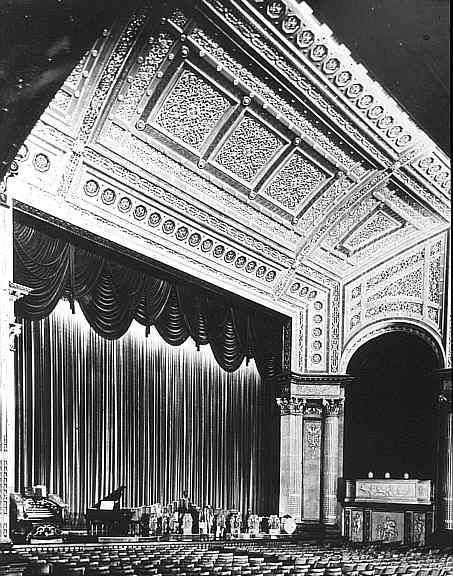
Its auditorium was the last of the great old-style picture palaces to be built in Australia:
.jpg)
.jpg)
.jpg)
.jpg)
.jpg)
.jpg)
.jpg)
Above photographs by John Thiele
An even greater surprise is that the organ was replaced as well. Since Hoyt's had not installed organs in any of their theatres for a decade and a half, it might have been expected that they would not have replaced the Regent organ. One suggestion, which may well provide the answer is that the insurance company stated that they had paid out for an organ, so another had to be installed. ["Brief History of the Regent Theatre", SA TOSA News, TOSA (SA), Adelaide, December, 1982, p. 4]
Hoyt's managed to get their organ at minumum expense, thus no doubt maximising their insurance return. They removed the 3/15 Style 260 Wurlitzer from the Ambassador's Theatre in Perth, which theatre they had acquired in 1937 following the disbandment of General Theatres Corporation (which had been formed by a merger of Hoyt's and Union Theatres in 1932). [Tod, Les, and Cook, Kevin, The Dream Palaces - Part One: The Atmospherics, Australian Theatre Historical Society Inc., Seven Hills, NSW, 1988, p.13] They also removed the 2/7 Style 185 Wurlitzer from the Lyceum (Paramount) Theatre in Melbourne.
.jpg)
The two instruments were combined into a four-manual nineteen-rank organ by Cliff Smith, who had worked for Hill, Norman & Beard Australia Pty Ltd before establishing his own business. The Ambassador's console was reconstructed and enlarged by the Howard Piano Company of Richmond. Others who worked on the reconstruction project were Harry Taylor, of Taylor & Sons, Organ Builders, Hawthorne, Harry Mariner, pipe maker, of Ringwood, Arthur Pyers (responsible for electrical work and wiring) and Pat Quinlan (assisted with console installation). ["March Out", Final concert programme at Regent Theatre, Melbourne, 12 January, 1969, p. 4]

The organ had a very rich and lush sound in the huge auditorium, and its nineteen ranks were distributed between three chambers:
Main chamber (left): Tuba Horn, Diaphonic Diapason, Clarinet, String, Viol d'Orchestre, Viol Céleste, Flute, Vox Humana.
Solo chamber (right): Trumpet, Tibia Clausa, Orchestral Oboe, Kinura, Saxophone, Oboe Horn, Quintadena.
Orchestral chamber (left): Open Diapason, Oboe Gamba, Tibia Plena, English Horn.
Full stoplist of the 1947 organ
.jpg)
Photo: Julien Arnold
The contents of the orchestral chamber were derived from the Lyceum (Paramount) 2/7 organ, which it may be recalled had the following ranks: Tuba Horn, Diaphonic Diapason, Clarinet, Viol d'Orchestre, Viol Céleste, Flute and Vox Humana.
One can imagine that considerable modification to the voicing of certain ranks of pipes was necessary to create the Oboe Gamba (ex-Clarinet??), Tibia Plena (ex-Flute??) and English Horn (ex-Tuba Horn??) ranks. Certainly, the English Horn never, at least on records, had the "bite" obtained from the Wurlitzer and other builders' ranks of that name.
The console was located on a lift at the left-hand side of the orchestra pit. The (upright) piano was housed in a small chamber on the left-hand side of the proscenium. During the 1950s, the organ console was moved into the decorative box at circle level on the left-hand side of the theatre, a position which made it difficult for organists to hear a proper balance between the different chambers.
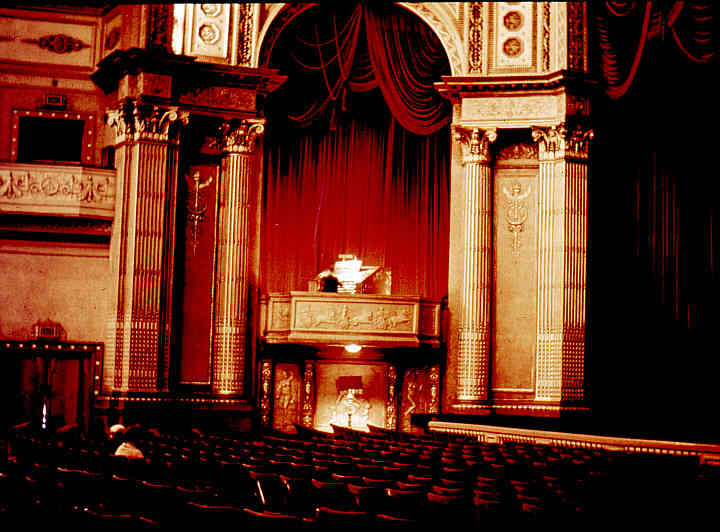
Photo: Julien Arnold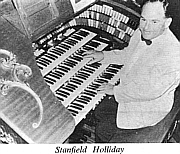
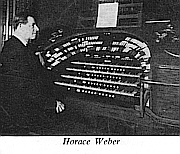 It was planned that Lionel Corrick would
inaugurate the organ, and he was named
in the souvenir programme for the
reopening show. However, he left Hoyt's a
few days before the opening. Len Davis
was the opening and first resident
organist; he stayed until February, 1948.
Hoarce Weber then featured until August, 1949, when Geoff Robertson arrived,
remaining until 1952. He was followed by Stanfield Holliday, whose residency
continued until 27 January, 1961, ["Shock Headlines", Vox, TOSA (Vic), Melbourne, February, 1961, p.
1]when the organ ceased to be featured on a regular basis.
It was planned that Lionel Corrick would
inaugurate the organ, and he was named
in the souvenir programme for the
reopening show. However, he left Hoyt's a
few days before the opening. Len Davis
was the opening and first resident
organist; he stayed until February, 1948.
Hoarce Weber then featured until August, 1949, when Geoff Robertson arrived,
remaining until 1952. He was followed by Stanfield Holliday, whose residency
continued until 27 January, 1961, ["Shock Headlines", Vox, TOSA (Vic), Melbourne, February, 1961, p.
1]when the organ ceased to be featured on a regular basis.
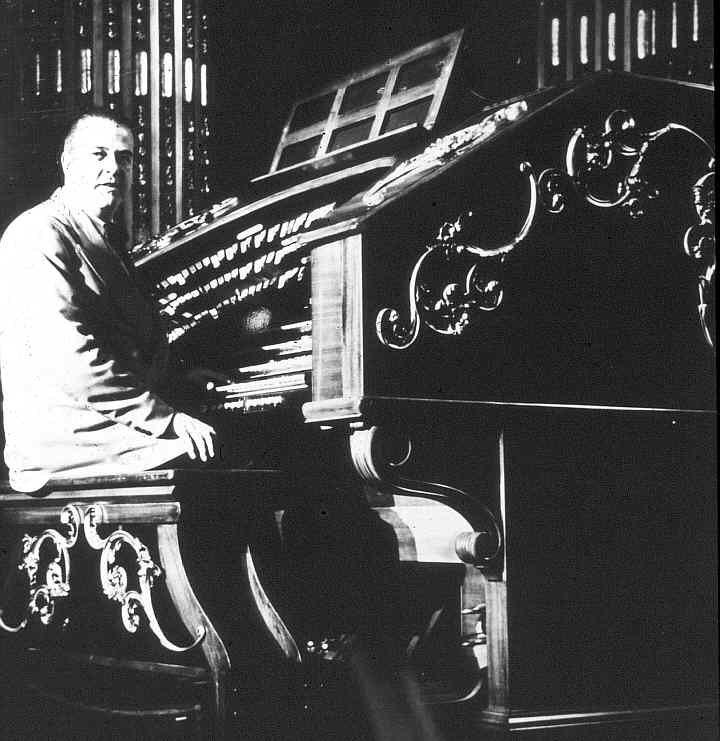
Geoff Robertson at the console
At that time, rumours were rife that the Regent was to close, and, indeed, there were proposals, which were not pursued, to split it horizontally into two cinemas. [Thorne, Ross, Cinemas of Australia via USA, Sydney, 1981, p.304.] The organ was not featured in public for some three years, but was revived for special film shows on 10 April, 1964 (with Horace Weber), [Vox, TOSA (Vic), Melbourne, April-May, 1964, p. 1]and 20 June, 1964 (with David Cross).[Vox, TOSA (Vic), Melbourne, April-May, 1964, p. 3] On 24 December, 1964, Tony Fenelon was engaged to play nightly for the Christmas season. That engagement extended until 12 January, 1969, when the organ was heard for the last time at a farewell concert following its sale.
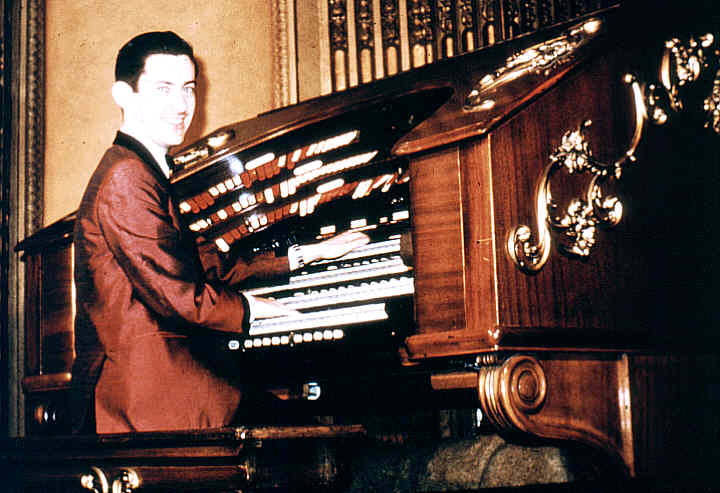
Tony Fenelon at the Console Photo: John Thiele
The organists at the hastily-arranged "March Out" concert were Tony Fenelon, Gordon Hamilton (who, with Mervyn Welch, had frequently relieved the Regent organists during the 1950s) and Alan Tranter, the purchaser of the organ. ["March Out", Final concert programme at Regent Theatre, Melbourne, 12 January, 1969]
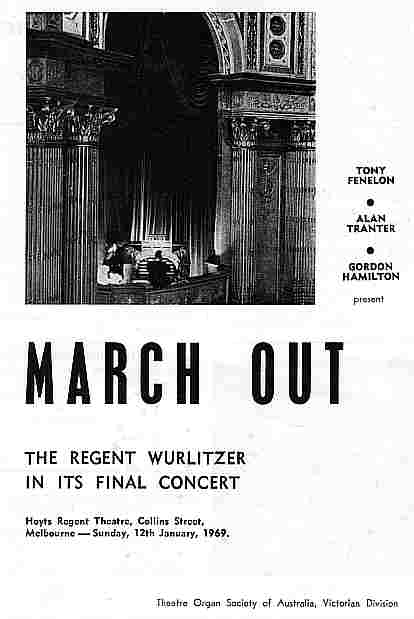
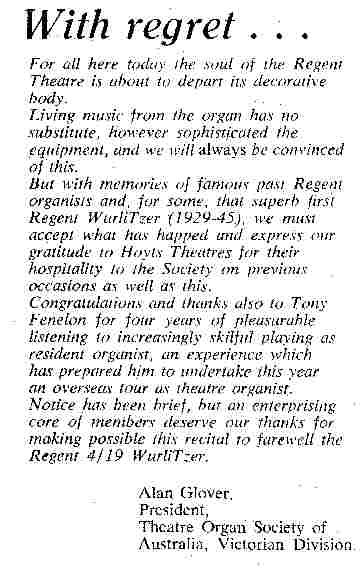
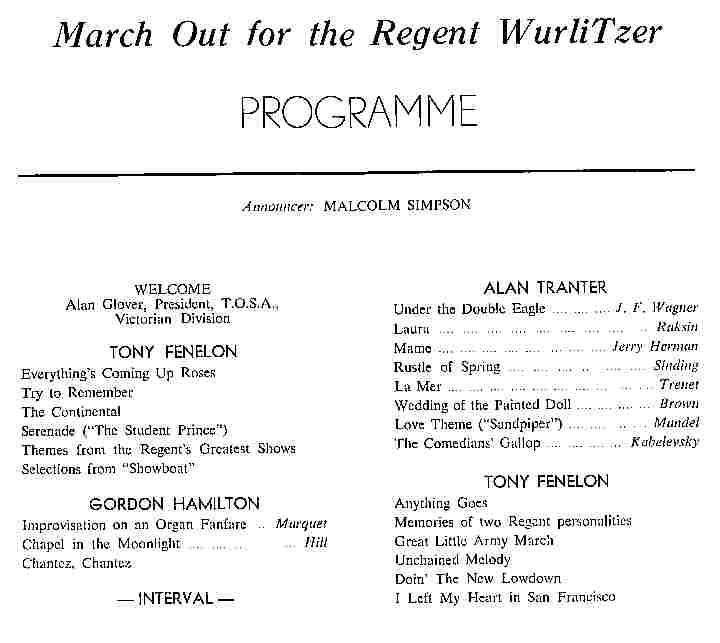
The second Regent organ was broadcast extensively by both Stanfield Holliday and Tony Fenelon, both of whom also cut several LP recordings on it. Tony achieved world renown through a series of excellent recordings he made at the Regent, and he was soon recognised as a world-class concert organist. It was certainly his Regent recordings that put Australia on the world theatre organ map.
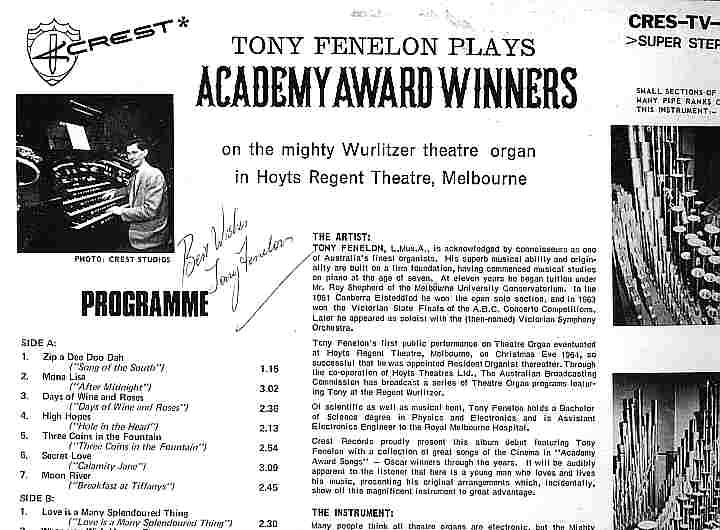
The record that showed the world that Australia's theatre organ scene had something special to offer
As has been stated above, the organ was sold to Mr Alan Tranter, who removed it to storage at his parents' home in Oakleigh, Vic. [Vox, TOSA (Vic), Melbourne, January, 1969, p. 3]To date, it has remained in storage.
The Regent Theatre closed on 1 July, 1970, without ceremony, as did the Regents at South Yarra and Ballarat on the same night.
"A handful of [TOSA] members were in the audience of around 600 who attended the final night of the fabulous 3300-seat Regent Theatre, Collins Street, Melbourne, on July 1st. It was a non-publicised event, and certainly had a terrible pair of films to accompany this tragic night. The only bright spark in the evening performance was the playing of tapes of Tony Fenelon playing the now-removed 4/19 Regent Wurlitzer. These must have been private tapes, as we have never heard them before." ["Regent Closes", Vox, TOSA (Vic), Melbourne, July, 1970, p. 9]
The Regent and Plaza theatres were stripped of furniture and fittings, which were sold as 714 lots in a two-day auction sale on site on 1st and 2nd December, 1970. ["Regent and Plaza Furnishings go under Hammer", Vox, TOSA (Vic), Melbourne, January-February, 1971, p. 6]
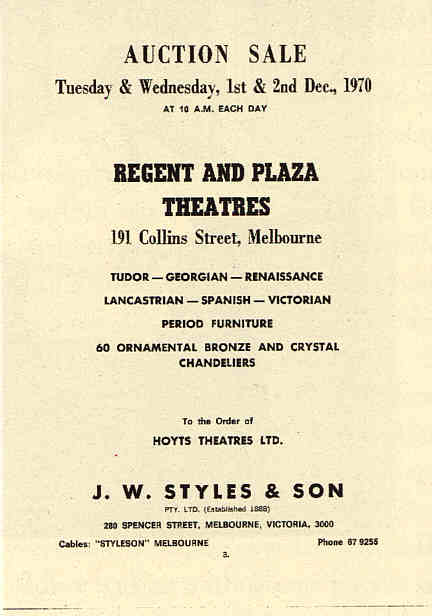
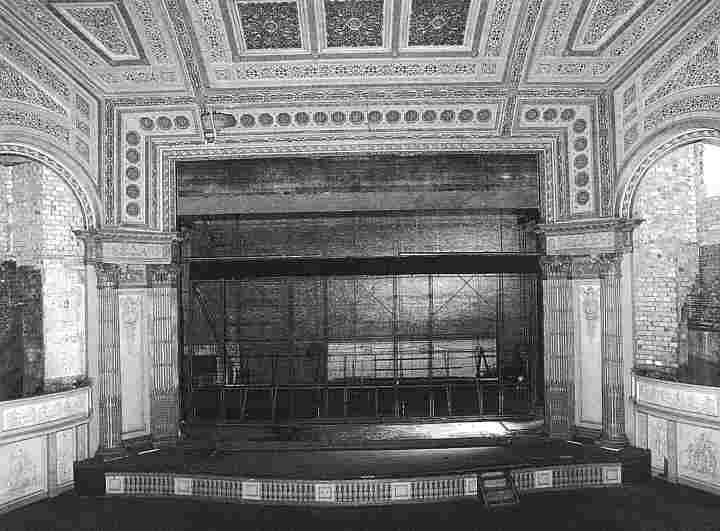
For almost a quarter of a century, controversy raged as to what was to become of the building, which was purchased by Melbourne City Council with a view to demolishing it and incorporating its site (and that of the Plaza below) in a City Square. There is not space here to list all the proposals which were put forward over those years.
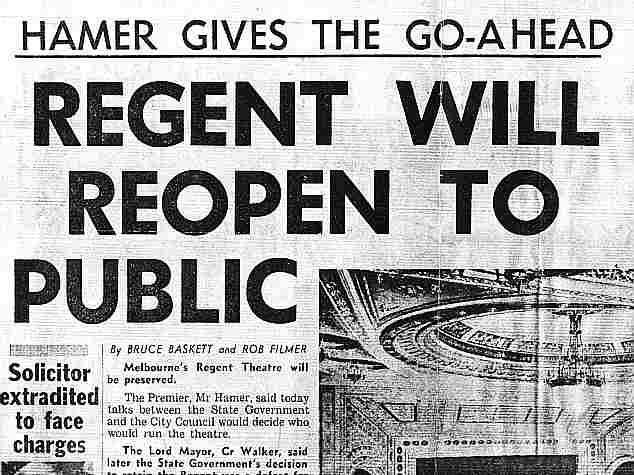
The Herald - 23 September, 1975 - It was to be over twenty more years before the Regent reopened
Much of the early controversy is summarised in the August/September, 1976, issue of Architecture Australia (pages 29-39).
Finally, it was announced in The Age on 2 April, 1993, that the Regent was to be restored, with work expected to start in September, 1993, and the theatre opening in January, 1996. Hopes were expressed that an organ might be included in the scheme. [SA TOSA News, TOSA (SA), Adelaide, May, 1993, p. 5]
This happy news was confirmed late the following year, when it was announced that the $25 million refurbishment programme was not only going ahead, but that a Wurlitzer organ, the largest ever to come to Australia, had been purchased in America for installation in the theatre. The instrument, of four manuals and thirty-six ranks of pipes is a vintage (1921) Style 285 organ first installed in the Granada (later Paramount) Theatre, San Francisco, and latterly privately owned in Portland, Oregon. [Vox, TOSA (Vic), Melbourne, October, 1994, p. 1]By the end of 1994, the organ had arrived in Australia, and work to prepare it for installation in the Regent had commenced. ["The New Melbourne Regent Organ", SA TOSA News, TOSA (SA), Adelaide, March, 1995, p. 9]
.jpg)
Photo: The Australian Way, April, 1998, p.35
Having undergone a complete restoration lasteing several years, the Regent Theatre, now better in many ways than it had been in 1947, was formally re-opened on 17 August, 1996.
.jpg)
.jpg)
.jpg)
.jpg)
Above photos: The Regent Theatre, Melbourne's Palace of Dreams (1996 Re-opening Brochure)
The organ that had originated in the Granada, San Francisco, was Wurlitzer's Opus 416, shipped from the factory on 16 May, 1921. At that time, the Wurlitzer company was making a promotional film, and many of the details of the organ's construction are depicted in it, concluding with a complete train leaving the factory, transporting the instrument on its long journey across America to California. That film still exists and was shown at the Regent when the organ was reopened in 1999. Video tape copies of the film in PAL and NTSC formats can be ordered from Hollywood's Attic.
A highly compressed and rather jerky MPEG4 version (3.6 MB) of the film can be downloaded here. You will need Windows Media Player or some other suitable viewer to play it. The accomapniment to this silent film is by Ray Brubacher.
The instrument was a Style 285, being an improved version of the 4/32 instrument built in 1917 for the California Theatre, San Francisco, a theatre owned by the same organisation that built the Granada. The California Theatre instrument (Opus 140) had only a 37-note Solo manual, which was dedicated to a few short-compass ranks, and the overall level of unification was far less than in the Style 285.
The Granada organ featured frequently in Wurlitzer's advertising, and is generally regarded still as being the architypal reference early Wurlitzer organ, as the Paramount, New York (and its twin at the Fox, San Francisco) were to be regarded for the later Wurlitzer styles. In other words, it was the finest organ Wurlitzer had built to date and is one of their all-time classics.
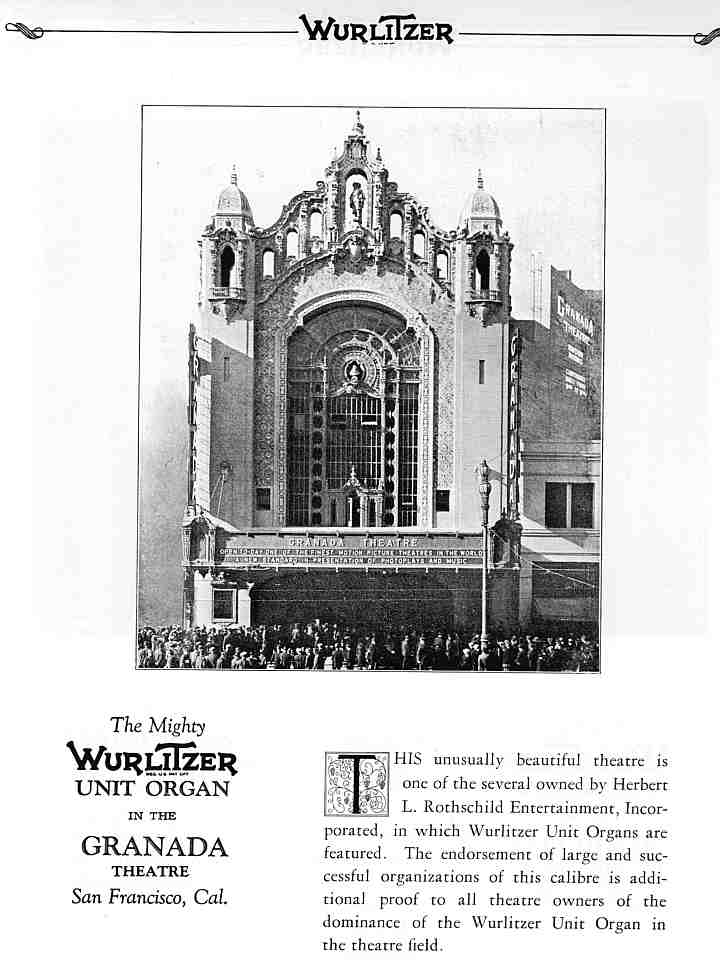
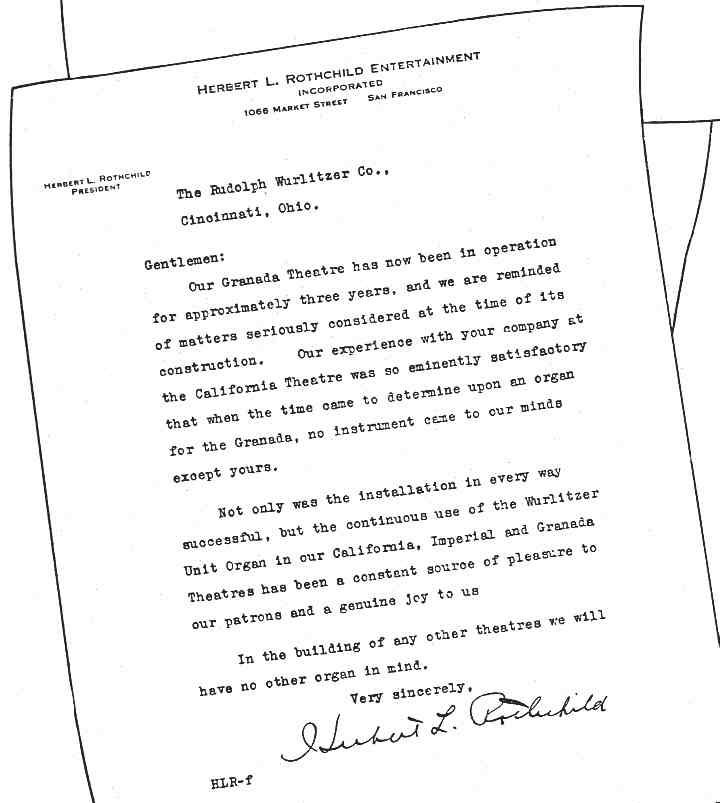
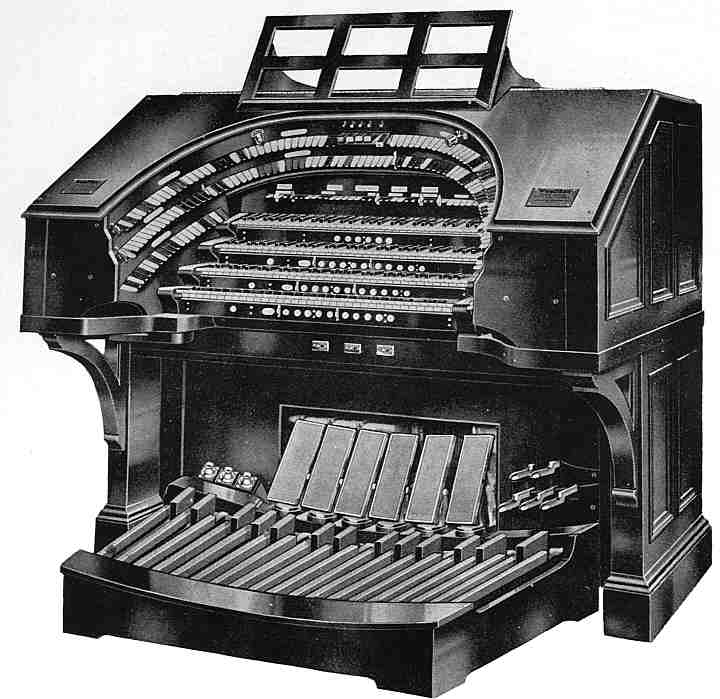
At the Granada, the organ originally comprised the following 32 ranks of pipes and tonal percussions:
Tuba Mirabilis 16' 85 pipes
Trumpet 8' 61 pipes
Tuba Horn 16' 85 pipes
English Horn 16' 73 pipes
Diaphonic Diapason 16' 73 pipes
Open Diapason 8' 61 pipes
Tibia Clausa 16' 85 pipes
Orchestral Oboe 8' 61 pipes
Kinura 8' 61 pipes
Solo String 16' 73 pipes
Horn Diapason 16' 73 pipes
Gamba 8' 73 pipes
Gamba Celeste 8' 73 pipes
Saxophone 8' 61 pipes
Clarinet 16' 73 pipes
Viol d'Orchestre 8' 85 pipes
Viol Celeste 8' 73 pipes
Krumet 8' 61 pipes
Oboe Horn 8' 61 pipes
Salicional 8' 61 pipes
Quintadena 8' 61 pipes
Concert Flute 8' 85 pipes
Vox Humana 8' 61 pipes
Harmonic Flute 4' 73 pipes
Piano 85 notes
Marimba 49 notes
Cathedral Chimes 25 notes
Glockenspiel 25 notes
Master Xylophone 37 notes
Xylophone 37 notes
Glockenspiel 37 notes
Chrysoglott 49 notes
ECHO - Playable from Pedal and Great
Horn Diapason 8' 61 pipes
Gamba 8' 73 pipes
Gamba Celeste 8' 73 pipes
Viol d'Orchestre 8' 73 pipes
Viol Celeste 8' 73 pipes
Oboe Horn 8' 61 pipes
Concert Flute 8' 97 pipes
Vox Humana 8' 61 pipes
Cathedral Chimes 25 notes
How these resources were distributed between seven chambers and across the four manuals and pedals can be seen in the analytical specification which also details the additions and changes that occurred during the organ's history prior to its purchase for the Regent.
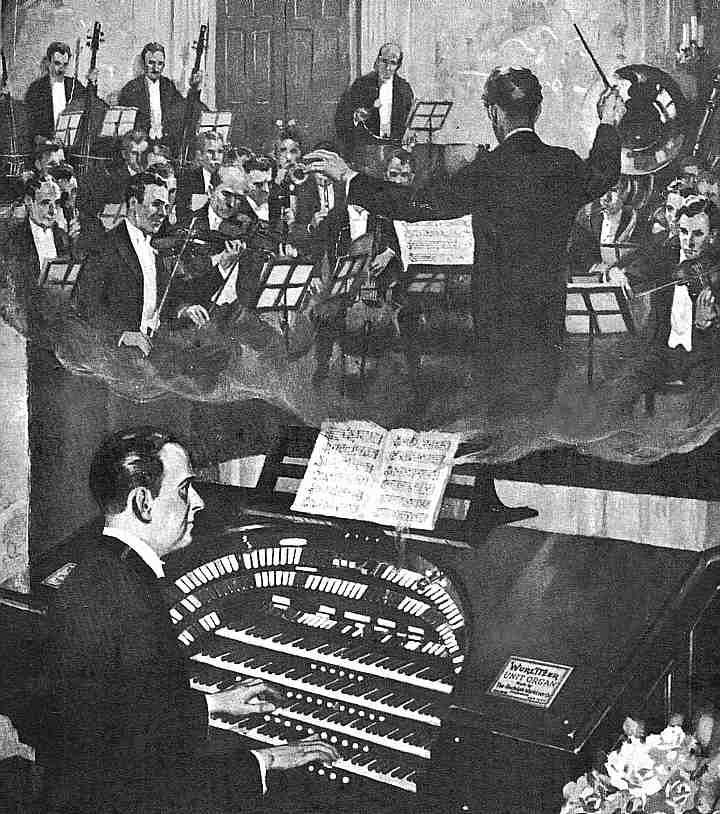
The Granada organ was featured on the cover of Wurlitzer's 1926 Unit Organ catalogue. The organist depicted is Henry Murtagh, Wurlitzer's senior demonstrator - whatever mood the silent film required, the Granada's organ could conjure it up.
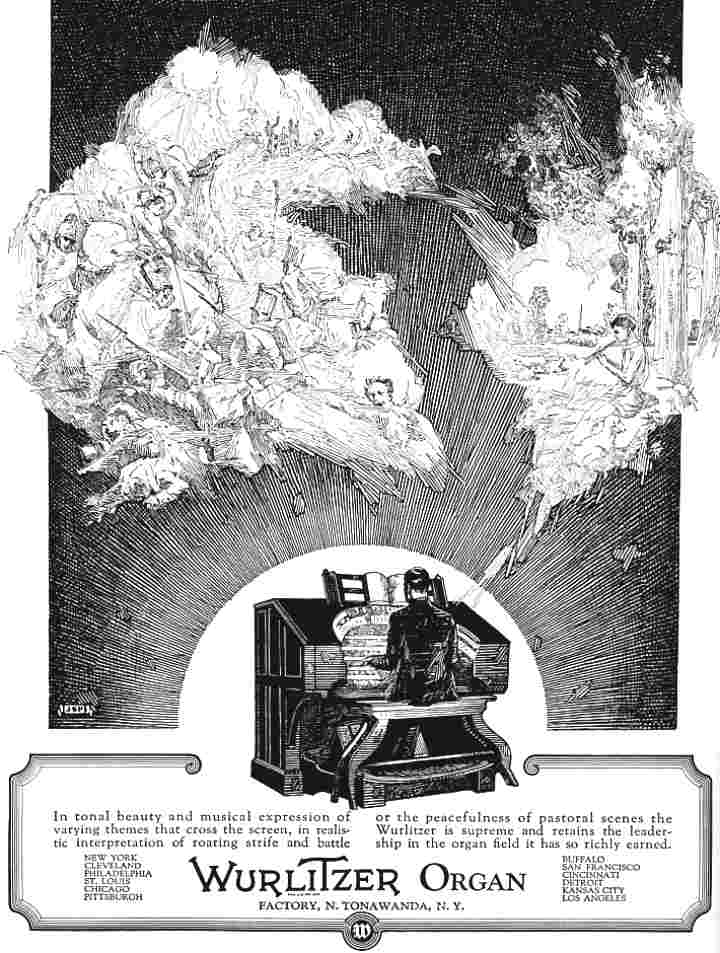
In the 1960s, the wife of Howard Vollum purchased the organ from the Granada, by then known as the Paramount, as birthday gift for her husband. How this paragon amongst women managed to hide it and wrap up the 32ft Diaphones for the birthday morning is not recorded. She certainly saw that he had a hobby to keep him occupied, as he not only had to put the organ together, but had to build a studio to house it. He also added a few extra ranks to it.
In time, Mr Vollum passed on, and the organ went into the ownership, first of Dave Junchen, and then of that great proponent of the finest in theatre organs, Jasper Sanfillipo. Neither of these gentlemen reassembled it.
Through protracted negotiations by several people including Lyn Larsen, the organ was purchased by Stage Developments Australia, a company jointly owned by David Marriner and the Construction and Building Union Superannuation Fund, which was refurbishing the theatre. The refurbishment was being carried out for Regent Management, a company jointly owned by the Victorian State Government and the Melbourne City Council, which owns both the Regent Theatre and the organ. The Regent Theatre, and the Plaza Ballroom beneath, are leased to Marriner Theatres by Regent Management.
The organ was presented to the public for the first time, in a concert by Lyn Larsen and Tony Fenelon to a packed house of more than 2000 people on Easter Monday 5 April 1999. Organists at the Regent Theatre include John Giacchi, Tony Fenelon and John Atwell.
Members of this division of TOSA played a large part in the installation of the organ, and are responsible for its upkeep.
[From TOSA (Victorian Division)'s Website http://home.vicnet.net.au/~organ/pages/otherorg.html#Regent]
One cannot but be amazed that a commercial operators purchased a nearly 80-year-old organ that was disassembled and not able to be played, shipped it halfway around the world, and had it installed in a commercial theatre. The reconstruction and installation work, as well as ongoing maintenance, has been directed by Julien Arnold, an experienced TOSA(Vic) member with over 30 years' experience of such work on large Wurlitzer organs.
The organ is used in live theatre presentations and as part of film shows.
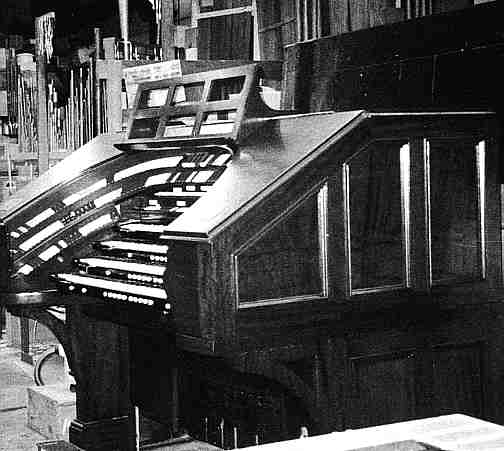
Photos: Julien Arnold
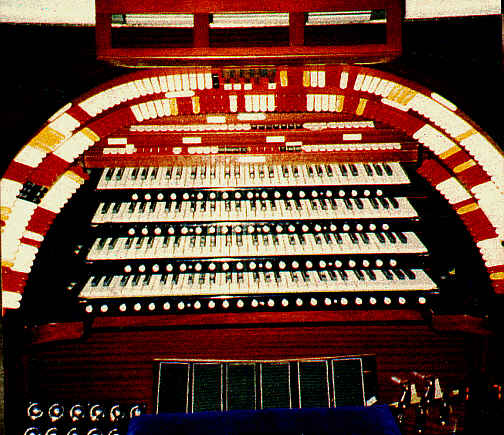
 The specification of the 36-rank organ can be found here
The specification of the 36-rank organ can be found here
Details of the 36 ranks and their location in the four chambers, together with their wind pressures, are shown in the table below. Then follow similar details for the percussions. These tables were produced while the organ was being installed, so there may be minor differences with the final result. Some manuscript notes and amendments by the designer can be seen.
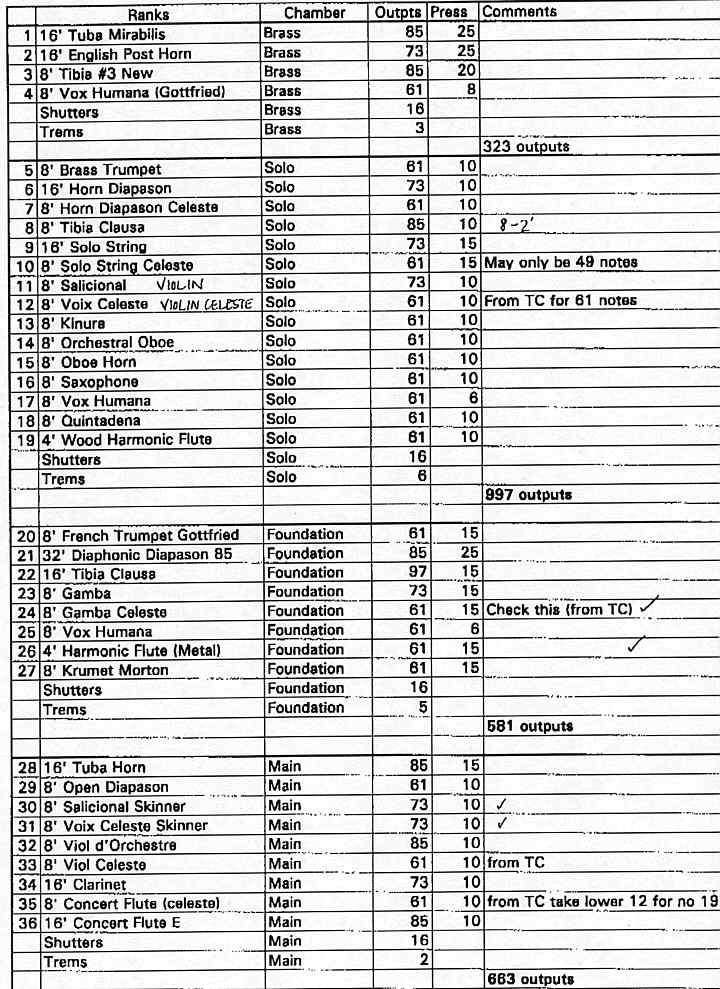
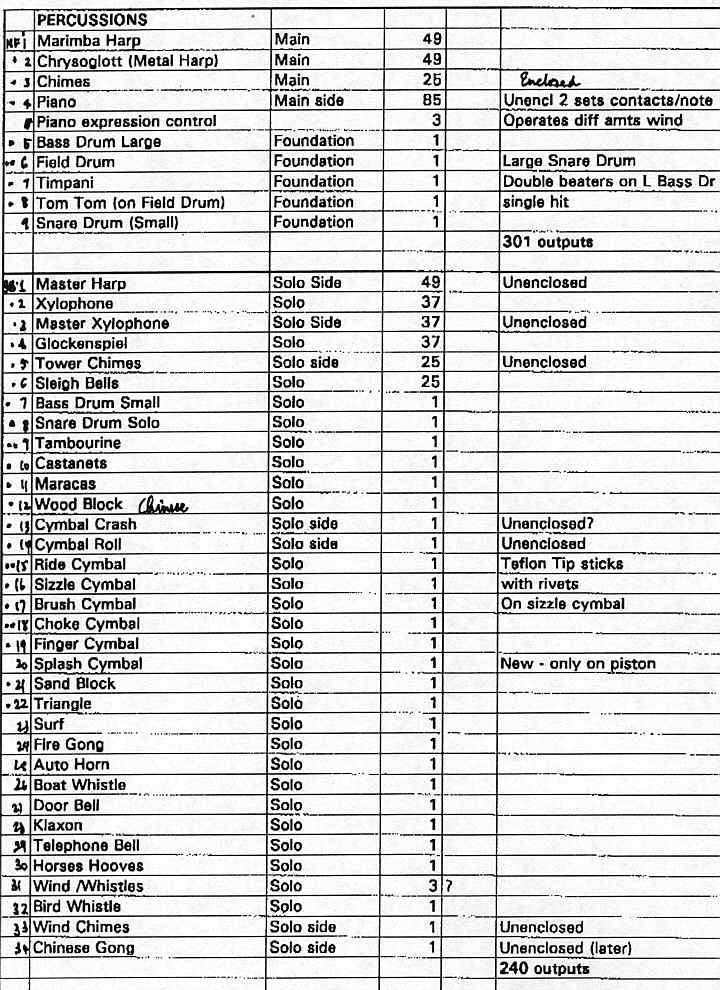
How these components translate into stopkeys at the console can be seen in the diagrams below. For ease of reading, the whole horseshoe is shown first, then each half enlarged.
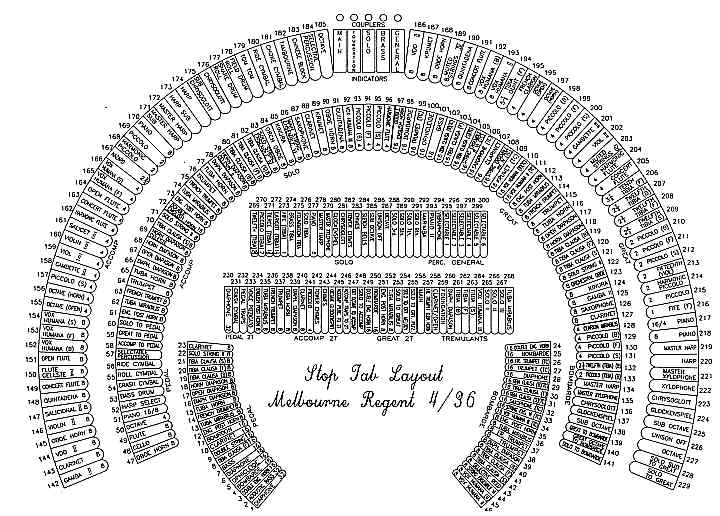
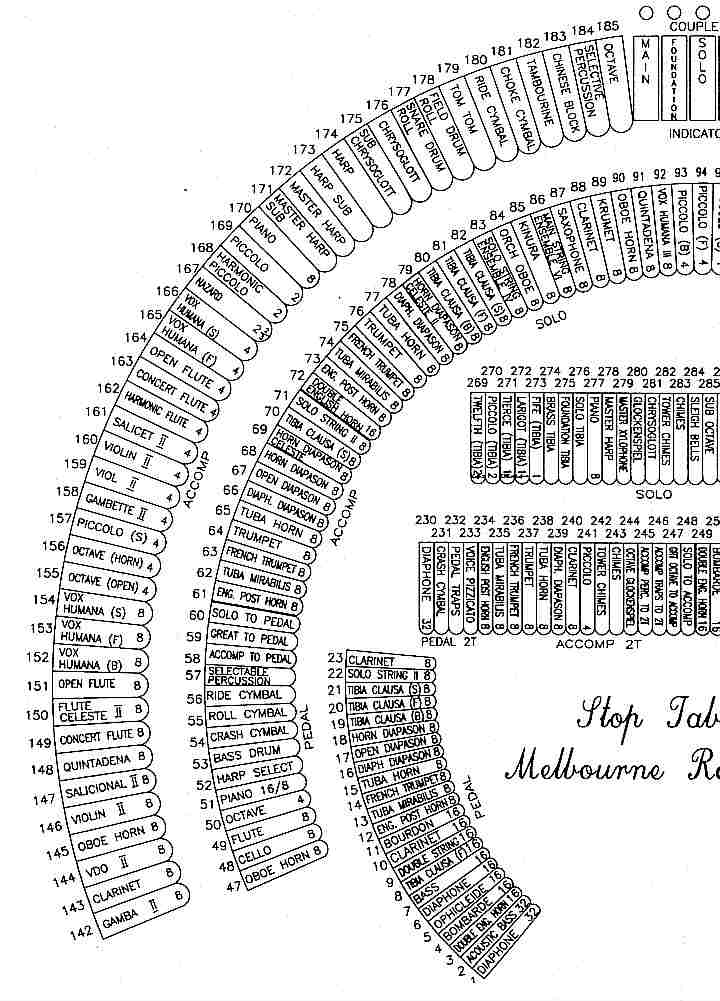
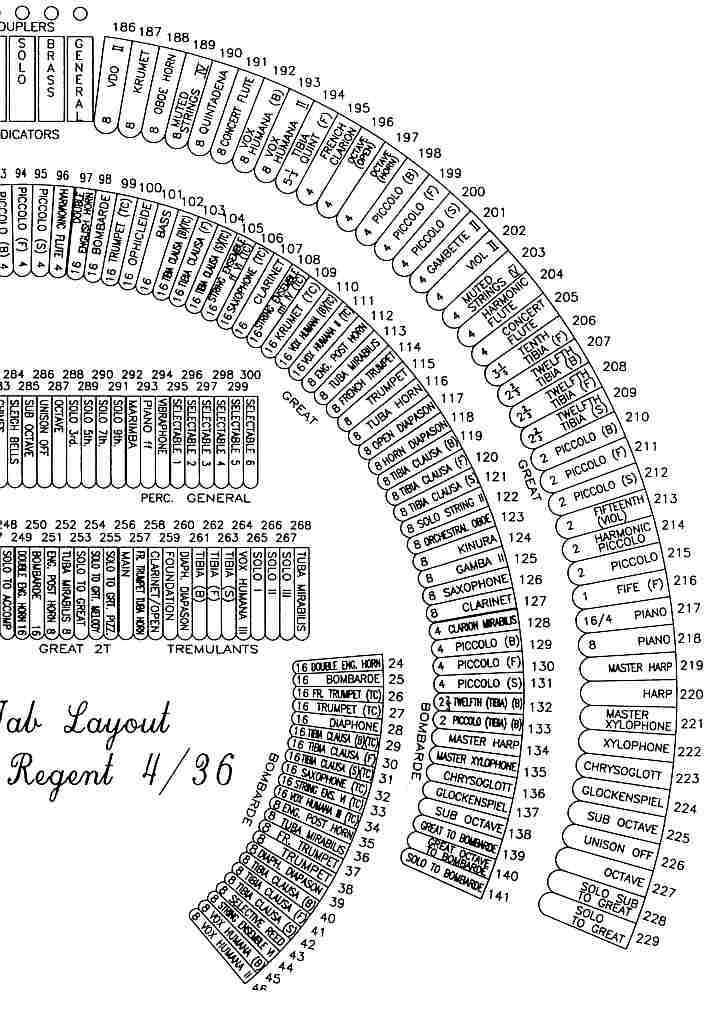
Other console details include two swing-out drawers on either side. The extent of the detailed planning required for such a large and complex console is very apparent:
